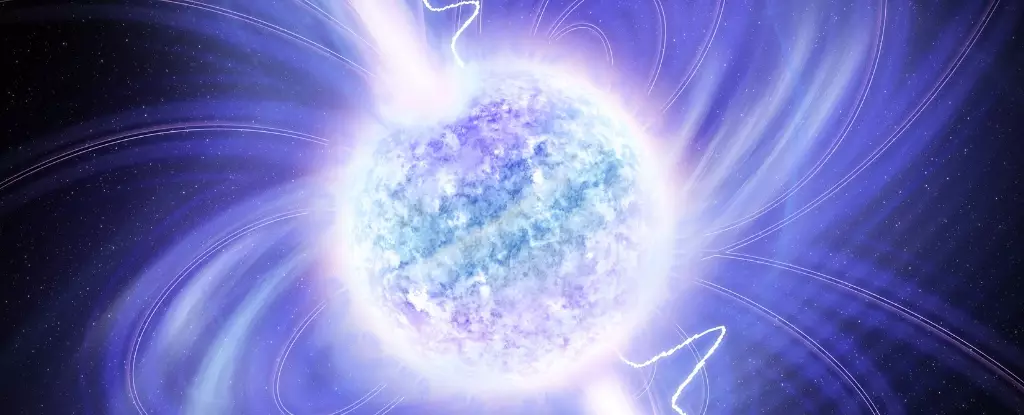Astronomy continually confronts our understanding of the universe, and recent discoveries highlight the intricate dance of cosmic forces that govern celestial bodies. The enigmatic object ASKAP J1839-0756 represents a striking challenge to our established comprehension of neutron stars and pulsars. As a slow-emitting cosmic lighthouse, this discovery compels astronomers to reconsider the parameters that define these astronomical phenomena.
Pulsars have long fascinated scientists as they emit concentrated beams of radio waves that rotate with immense speed, likened to a lighthouse casting its beam across the seas. Typically, these neutron stars encompass a swift rotational period, completing a full spin in mere seconds or even less. The periodic nature of their radiation is pivotal for understanding stellar evolution; however, the emergence of ASKAP J1839-0756 presents a significant deviation from the norm, spinning once every 6.5 hours—a pace that fundamentally shifts the landscape of pulsar research.
An Unexpected Discovery
Identified by the Australian Square Kilometer Array Pathfinder (ASKAP) radio telescope, ASKAP J1839-0756 came to light during routine observations in Western Australia. Initially, this cosmic body raised eyebrows with its unique radio emissions, which drastically diminished by 95% over a remarkably short duration. This unexpected dip in brightness led researchers to suspect there was more to this entity than met the eye, prompting extensive follow-up observations across several ground-breaking observatories, including the Australia Telescope Compact Array and MeerKAT.
Upon deeper analysis, astronomers discovered two distinct radio pulses spaced 6.5 hours apart. However, this find was layered with complexity, primarily because conventional astrophysical theory postulates that once a neutron star’s spin rate dips below a certain threshold, it should cease radio emissions altogether. Thus, ASKAP J1839-0756 catalyzes a reevaluation of the principles that underlie these celestial entities.
A defining characteristic of pulsars is their ability to convert rotational energy into radiation. In the case of most pulsars, the alignment of their rotational and magnetic axes enables us to observe their radio emission from a singular magnetic pole. Conversely, rare `interpulses`—double flashes from a pulsar—arise when the axes are almost perpendicular, allowing us glimpses from two poles. The peculiar behavior of ASKAP J1839-0756 not only accentuates the rarity of its rotational speed but also positions it as the first slow-spinning object to demonstrate these interpulses.
With the primary pulse occurring every 6.5 hours, ASKAP J1839-0756 presents a weaker pulse approximately 3.2 hours after the main emission. The significance lies in the suggestion that this emission emerges from the opposite magnetic pole, granting astronomers unprecedented insight into the star’s geometric and magnetic attributes. As the enigma deepens, questions linger about the potential variations in alignment between magnetic and rotational axes during periods of deceleration.
One of the leading theories that arises in conjunction with ASKAP J1839-0756 is its potential classification as a magnetar—a neutron star known for its exceptionally intense magnetic field. Magnetars exhibit radio emissions through unique mechanisms that may permit their existence at slower spin rates. Despite this, the extrapolation challenges existing knowledge, as even magnetars rarely engage in radio emission at such leisurely intervals. The only known exceptional case is a magnetar that spins every 6.67 hours but emits exclusively in X-rays, throwing further complexity into the narrative.
An alternative hypothesis suggests that ASKAP J1839-0756 could belong to the category of white dwarfs—the remains of less massive stars. But thus far, no isolated white dwarfs have been recorded as sources of radio pulses, and no observations in other spectra reveal any related evidence in the vicinity of the object. The intricacies of ASKAP J1839-0756 persist, as scientists grapple with its classification while casting a wider net to explore the scope of cosmic anomalies.
ASKAP J1839-0756 epitomizes the essence of discovery in the cosmic narrative. It serves as a poignant reminder that our comprehension of the universe remains in flux, continuously rewritten by revelations that confound the established principles of astrophysics. As astronomers persist in their efforts to monitor and decipher the underlying mechanisms of this cosmic anomaly, the future promises to unveil further secrets that challenge our understanding of the cosmos.
Thus, the journey to fathom ASKAP J1839-0756 is not merely about understanding a newfound astronomical entity; it is emblematic of humanity’s broader quest to illuminate the mysteries of the universe—an endeavor that is inherently filled with surprises and revelations.


Leave a Reply